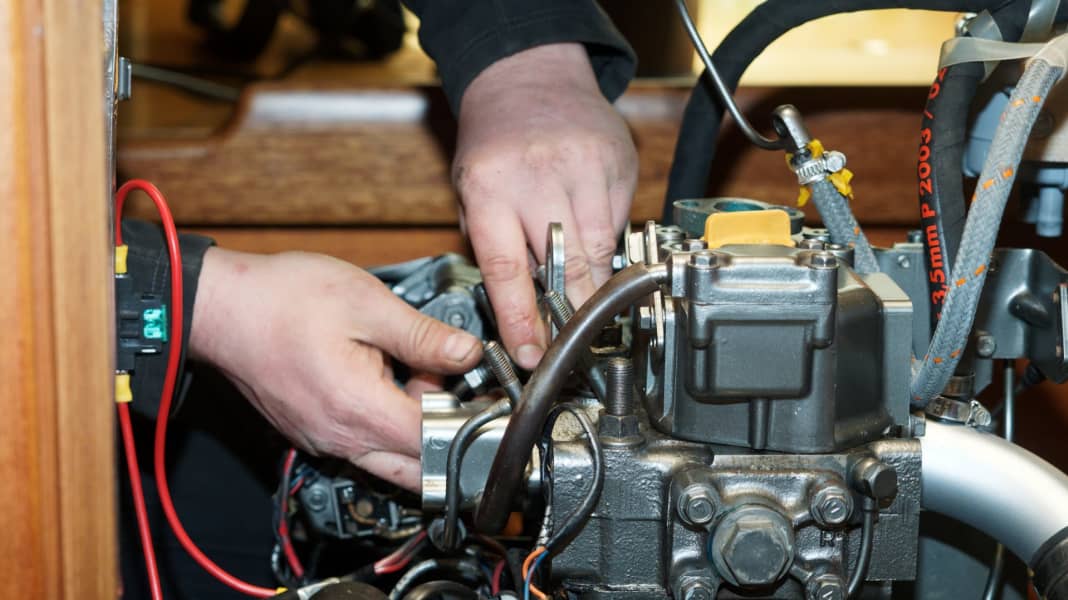
- Diesel system and diesel filter
- Oil change
- Cleaning the engine compartment
- Check transmission oil
- Seal of the shaft system
- Check V-belt
- Check cooling system for leaks
- Check seacocks
- Check impeller
- Check anodes
- Shift and throttle cables
- View motor anchoring
- Electrical system
- Air filter
- Commissioning
- Outboard motor
All topics of this Season start specials:
In autumn, the boat should be brought into winter storage with an almost full diesel tank. This prevents condensation, which favours bacterial growth and thus diesel pest. However, not full to the brim, there should still be around four to five per cent air left. Otherwise, the diesel may expand as temperatures rise and leak out of the air vents. The diesel should also be mixed with a biocide, such as Grotamar. This can only be ordered from a specialised company and no longer directly from the customer.
Diesel system and diesel filter
The entire diesel system should be checked for contamination in spring at the latest. The tank itself does not necessarily have to be inspected. There are usually water separators at the bottom of the filters. If the water collected there is OK, there is no need to worry. Empty and clean the water separator anyway! If, on the other hand, it is a foul-smelling "dirty broth", you can assume that you will have problems with blockages during the season. A sign of this is also slightly cloudy or milky diesel. Problems can also occur in the engine if there is too much water in the diesel. In all these cases, you should consult a specialist. In general, it is a good tip to consult a specialist from time to time. This is because engines are no longer the same as they were 50 years ago; there are electronics installed that can be read out, resulting in error messages that cannot be seen from the outside. This is why regular inspections are important. In addition, specialist workshops are informed by the manufacturers about faults or recalls. However, the specialists can only carry out the necessary work if you come to them.
The diesel filters should be replaced once a season. If heavy soiling has settled in the filter, it is essential to investigate the cause.
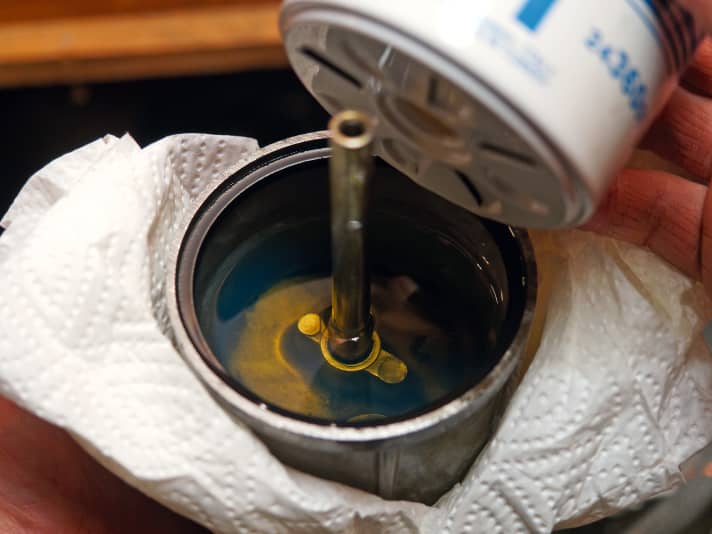
Oil change
The rule of thumb is to change the oil once a season, although this also depends on the operating hours. If you have only driven for five hours, the oil does not need to be changed. If possible, the oil should be changed before winter storage in order to remove all deposits from the engine before they can settle due to the long standing time. Change the oil filter at the same time. Allow the engine to warm up, but not too hot, otherwise you could burn your skin. Changing the oil in autumn also has the advantage that you can check in spring whether the oil level is still the same; if not, the engine could be leaking. However, if you neglect to do this in the autumn, you can do it again in the spring.
Cleaning the engine compartment
A clean engine and engine compartment are important in order to be able to recognise leaks such as those described above by means of oil leaks. However, flammable agents such as brake cleaner should never be used when cleaning. Otherwise flammable gases may form in the bilge. All it takes is a spark when starting the engine and the engine compartment is on fire.
Check transmission oil
The transmission oil should also be checked. On the one hand, check whether there is still enough, but also whether it has a greyish colour. This indicates leaks and water ingress. Especially if the engine has been standing for a long time, i.e. in spring, it is sufficient to briefly open the oil drain plug and check what comes out of it. This is because water settles at the bottom, and if there is any, it should flow out first. Half a shot glass full is enough to check this. If this is the case, the oil must be changed and you should look for the water ingress points.
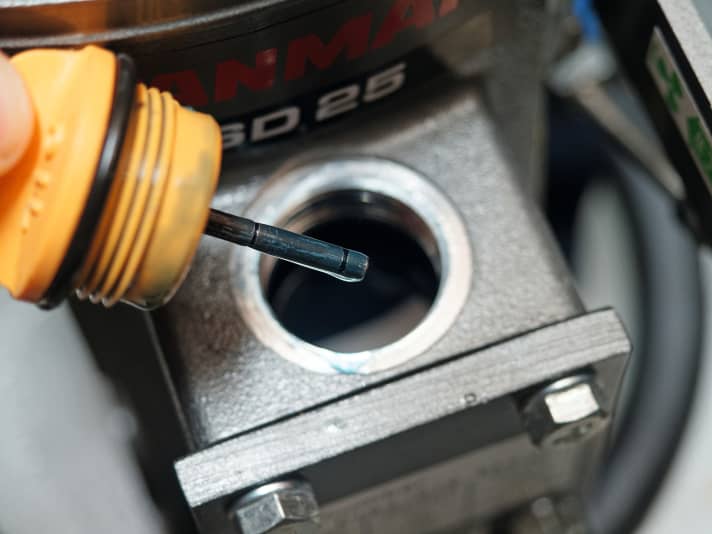
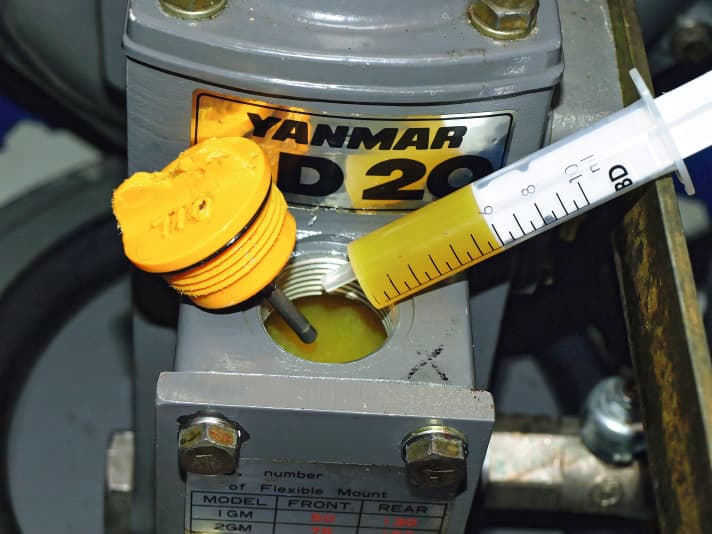
Seal of the shaft system
The seal of a shaft system should also be checked. If you still have a conventional bushing with a sealing cord, you should drive for a while before checking. This is because the cord dries out over the winter and may initially leak a little, but swells up again after a few hours. If it remains permanently leaky, the sealing packing must be tightened a little - but not too tightly, otherwise it will overheat - or a new packing must be fitted. Rubber seals should be watered before starting the engine. In winter, they can dry out and then an air bubble forms at the top, which can lead to reduced lubrication and cooling by the water. Squeeze these seals slightly when the boat is in the water to press out the air.
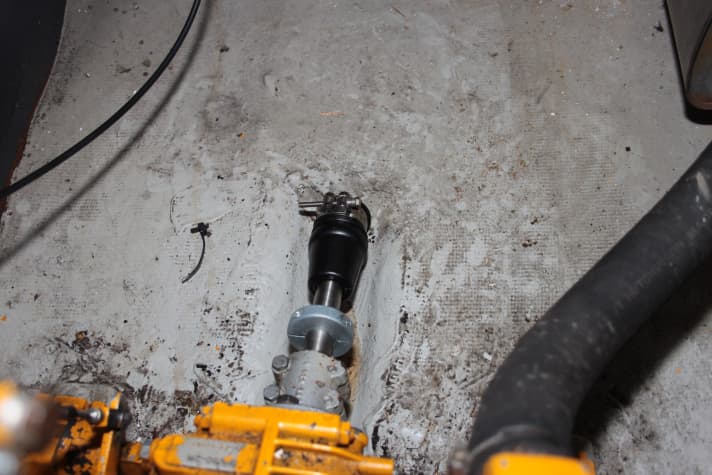
Check V-belt
The V-belts should not show too much wear, which can also be recognised by plastic flakes and black soot deposited on the engine or in the bilge. The tension is set correctly when you can push the belt through ten to 15 millimetres at the longest point, the width of a finger or thumb. The tension must not be too tight either, otherwise the bearings in the driven units such as the water pump or alternator could be damaged. The same applies to timing belts. They are correctly tensioned if they can be twisted by about 90 degrees at a longer point. If they can be twisted further, they are too loose; if they cannot be twisted at all, they are too tight.
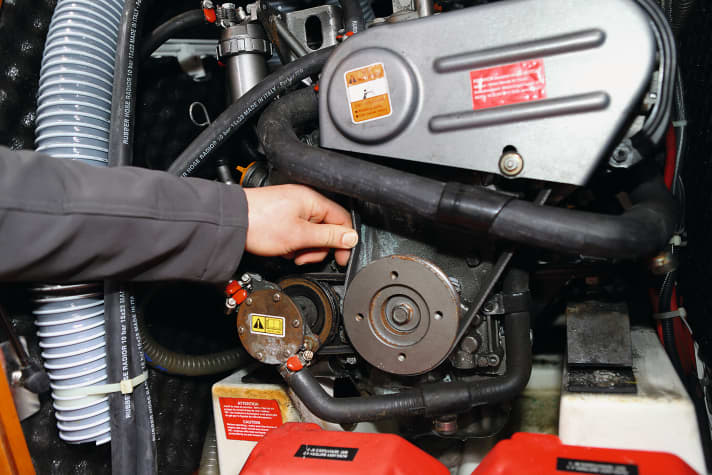
The V-belt and timing belt pulleys should not be rusted, as this increases wear on the pulleys themselves and the belts. Another point is the valve clearance. For engines that do not adjust this automatically, such as hydraulic tappets, you should have a specialist check it every 600 to 800 operating hours or five to six years, depending on the manufacturer. The trained ear of a good mechanic will immediately hear if something is wrong. It is usually not possible to check this yourself, as valve wear is a gradual process; the owner can hardly hear any differences.
Check cooling system for leaks
Are there any leaks, are the hoses porous or clogged, are all the hose clamps still tight? You can also tighten them all slightly to see if they have come loose. If the yacht is in unheated winter storage, the outer circuit must be filled with antifreeze for dual-circuit systems, and the inner circuit for single-circuit cooling systems. With these engines, warm up the engine beforehand so that the thermostats are open and the antifreeze can get everywhere. If biodegradable antifreeze is used, for example from Liqui Moly, it does not need to be collected when the engine is started up in the spring. Incidentally, if you launch your yacht very early, you don't need to worry. Normal night frosts of minus three to four degrees are usually not a problem, as the system thaws again during the day. However, if the frost lasts for several days, you should refill with antifreeze.
In dual-circuit cooling systems, you should check the storage tank to see whether the antifreeze, which is also corrosion protection, is still present in sufficient quantities and has the required concentration. This can be determined using an antifreeze spindle. If antifreeze needs to be topped up, it is essential to use the correct antifreeze that is already present - otherwise the different agents may react, resulting in flocculation, crystallisation or jelly formation or even blockage.
Check seacocks
Open and close them several times in autumn. Otherwise they can become very stiff after a long period of disuse. If they remain stiff even after repeated operation, this is a sign that they need to be replaced. Valves should also be operated more often during the season to prevent the build-up of limescale, which can then destroy the seals. If the boat is unheated, leave the sea valves open so that the ball area can dry out and prevent frost damage to the housing. This also has the advantage that the valves are open as soon as the boat is launched. Many people set off with the valves closed and are then surprised when the engine overheats.
Check impeller
Checking the cooling system also includes checking the seawater filter and the impeller of the pump as well as the tightness of the pump housing. Whether the impeller is still pumping sufficient water can be easily recognised by the cooling water jet at the stern. A weak jet could indicate blockages. If the machine is driven a lot, the impeller should also be replaced after some time as a precautionary measure; the manufacturers specify every two years.
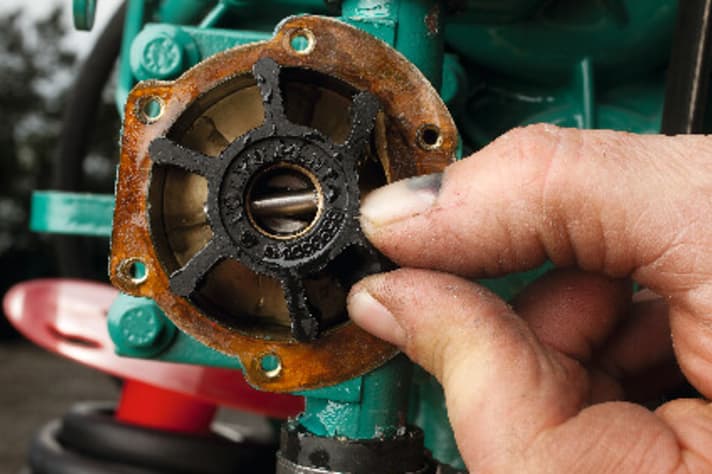
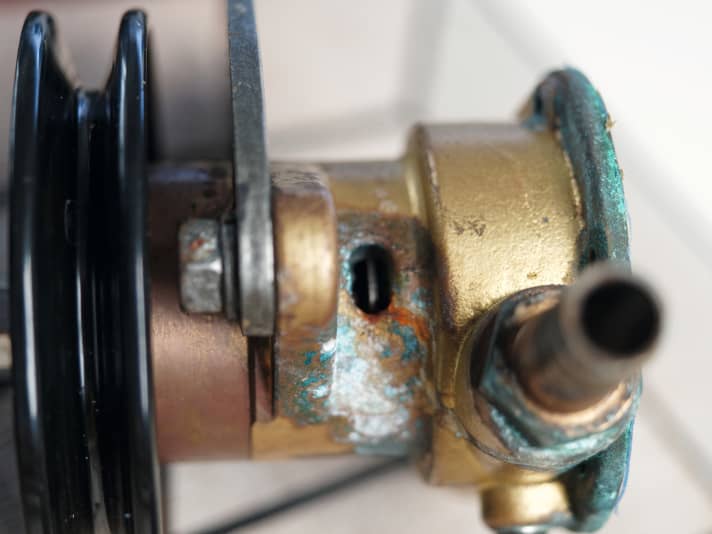
Check anodes
The anodes in the motor, which are intended to prevent galvanic corrosion in the machine, are often neglected. Where these are located and how they are checked varies from engine to engine, so you need to consult the operating instructions.
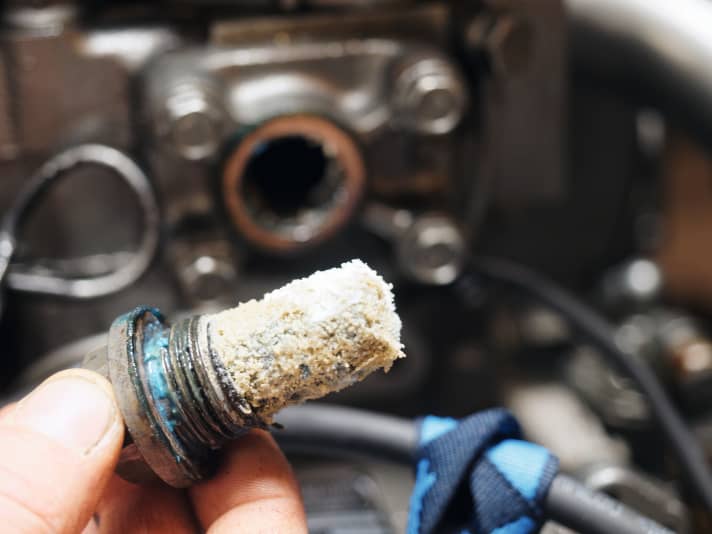
Shift and throttle cables
With the gearshift and throttle cables, you must check that the attachment to the lever and engine is intact. Particular attention should be paid to the tight fit of the lock nuts, otherwise the cables can become misaligned. A drop of oil can be applied to the bearing points, but do not use too much grease. This will only cause dirt to build up and the grease to resinify, which can lead to the cables becoming increasingly stiff. Check the cables themselves once to see if any brackets have come loose and a cable may be hanging loose.
View motor anchoring
You can check the motor foundation to see if the fastenings are tight. Slightly torn rubbers are not initially a problem. Only when the engine has settled to such an extent that it strikes somewhere, which can be heard and also felt by vibrations, must action be taken. In the case of a shaft system with a rigid coupling, the alignment should be checked every few years, as this can change due to the engine settling and cause damage to the shaft bearing.
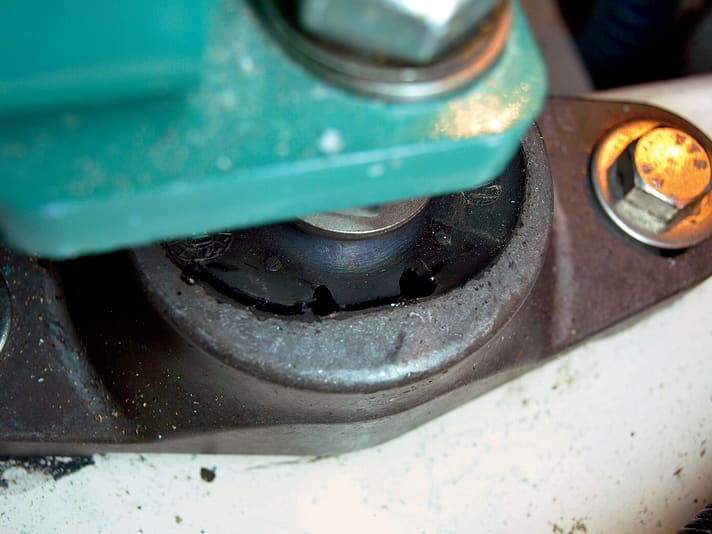
Electrical system
The electrical system should also be visually inspected to ensure that all plugs are still secure or corroded, especially on the starter motor and alternator. The earth connection should also be checked to ensure it is secure.
Air filter
If air filters are present, they should be cleaned or replaced.
Commissioning
Once this maintenance work has been completed, you should definitely open the engine compartment in the spring when starting up for the first time and check whether everything is running properly, whether there are any leaks or whether anything is conspicuous.
Motor checklist
- Oil change engine
- Gearbox oil check
- Filter change (diesel/oil, air)
- Impeller
- V-belt
- Cooling and fuel system
- Exhaust system
- Screw connections
- Flange
- Clutch
- Oscillating elements
- Shift cables
Download free of charge: Checklist for the start of the season PDF
Outboard motor
It is sometimes a long way to riding pleasure. Incorrect settings cause the small drive to run unevenly and cause recurring problems. On charter yachts in particular, outboards are pushed to the limit - and are therefore often prone to breakdowns. But what should you do if the help centre is many nautical miles away and the whirling engine is acting up again?






Download free of charge: Outboard motor checklist PDF

